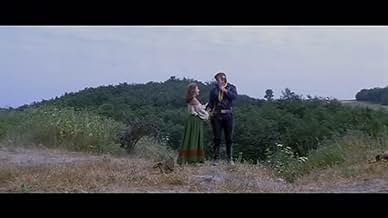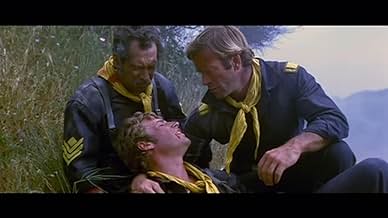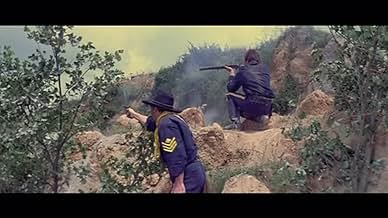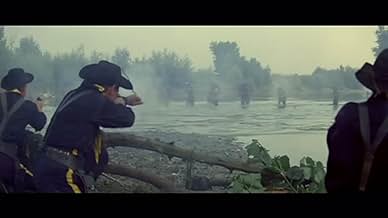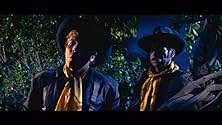NOTE IMDb
5,1/10
341
MA NOTE
Ajouter une intrigue dans votre langueA lone rider comes across a dying soldier, who gives him a paper authorizing the payment of $150,000 to the U.S. Army. The rider gathers some colleagues who disguise themselves as soldiers a... Tout lireA lone rider comes across a dying soldier, who gives him a paper authorizing the payment of $150,000 to the U.S. Army. The rider gathers some colleagues who disguise themselves as soldiers and who take the paper to a bank.A lone rider comes across a dying soldier, who gives him a paper authorizing the payment of $150,000 to the U.S. Army. The rider gathers some colleagues who disguise themselves as soldiers and who take the paper to a bank.
- Réalisation
- Scénario
- Casting principal
Alberto Cevenini
- Slim Kincaid
- (as Kirk Bert)
Gustavo De Nardo
- Sergeant Warwick
- (as Dean Ardow)
- …
Antonio Gradoli
- Captain Hull
- (as Anthony Gradwell)
- …
Gérard Herter
- Mr. Silver
- (non crédité)
Claudio Ruffini
- Sandy-Haired Gambler
- (non crédité)
Pietro Tordi
- Bartender
- (non crédité)
Avis à la une
Italian movie director Mario Bava is best known for his horror movies. But during his career he found time to direct other kinds of movies, including spaghetti westerns, "The Road To Fort Bravo" being one such example. The movie is pretty unknown, and it's easy to see why. Throughout it has the feeling of a slapdash production. The budget was obviously pretty low, so the production values are pretty tacky, from the costumes to the poor special effects. Bava seems unable to show any visual flair on this project, except for a few scenes that take place in caves. But the main problem with the movie is the script. It feels like a first draft, with many scenes feeling rushed or unfinished. This quickie enterprise is capped with a pretty bad musical score by Piero Umiliani, which consists of 60s style music at its worst. The best that can be said of the movie is that its running time is fairly short.
A lone rider comes across a dying soldier, the victim of an Indian attack, who gives him a paper authorizing the payment of $150,000 to the U. S. Army. The rider gathers some colleagues who disguise themselves as soldiers and who take the paper to a bank. They get the money but a shoot-out occurs, an old woman is killed, and the gang acrimoniously splits up. Later some members of the gang meet up with some real U. S. Cavalry soldiers.
Ken Clark stars in this Spaghetti Cavalry western which has more in common with the American western. Clark's character goes through some transformation during the course of betrayal, double crosses and romance. It's a serviceable western, well shot with some decent action and drama, but it can also plod and meander. Dull moments do appear, but the characters and action keeps things going.
Ken Clark stars in this Spaghetti Cavalry western which has more in common with the American western. Clark's character goes through some transformation during the course of betrayal, double crosses and romance. It's a serviceable western, well shot with some decent action and drama, but it can also plod and meander. Dull moments do appear, but the characters and action keeps things going.
I've only seen each of the 3 Bava spaghetti westerns once (neither among his best work or his preferred genre), but I disagree with many people who considered Nebraska Jim to be a better film. Strictly from an entertainment sense, Arizone Bill (La Strada per Fort Alamo) held my interest noticeably better (though admittedly the copy of Nebraska Jim that I saw had severely distraction issues with audio). While Nebraska Jim seemed like a mostly cookie cutter extended western TV show episode you'd expect to see on American TV, Arizona Bill was more like a 2nd rate Good Bad and Ugly wannabe with its stolen civil war funds plot line and a group of criminals that ranges from a couple of more 'decent' people who are criminals to outright despicable violent ones. It was just slightly different enough to make it more interesting to me and it felt more like a Bava film. Maybe if I rewatch these films a few more times I'll notice things I've overlooked which will explain others' preferences, but I'm a bit skeptical that that will happen.
It's not the greatest or most original film, but it kept me entertained and my biggest complaint is with regards to the 'romantic' subplot and its cheesy accompanying music (at least on the copy I saw, I'm not sure if it was or wasn't the original music used). Bava isn't always at his best when trying to provide romance/love interests to his films. Black Sunday (La Maschera del demonio) is IMHO the quintessential Italian Gothic horror film and a favorite of mine, but even his admirers have to admit that in that great film, the 'undying love' of the young Dr. Gorobec for Katia -- whom he has just met one day previous -- is a bit silly and one-dimensional and at times almost laughably overly melodramatic. I took off one point for the botched romance portions of Arizona Bill, though I did like it overall more than Nebraska which ended up with the same 5/10 score from me.
The copy of the film I saw was an English language widescreen version from an old somewhat glitchy videotape source with a runtime closer to the USA or German cuts. I'm not sure what was excised from the original 90 minute cut listed on IMDb and maybe when TL's big Bava book comes out it will tell us what is or isn't missing from the cut I saw, but I hope one of the cult DVD companies (like Image, Anchor Bay or Blue Underground) pick up both this title and "Nebraska Jim" sometime in the near future to provide Bava's fans with a good legitimate uncut DVD release with the best transfer possible considering whatever film elements exist. I'm sure the underrated director's fans would welcome quality releases of all his films, even the lesser known and hard to find ones where Mario took over directorial duties from a previous director leaving a project.
It's not the greatest or most original film, but it kept me entertained and my biggest complaint is with regards to the 'romantic' subplot and its cheesy accompanying music (at least on the copy I saw, I'm not sure if it was or wasn't the original music used). Bava isn't always at his best when trying to provide romance/love interests to his films. Black Sunday (La Maschera del demonio) is IMHO the quintessential Italian Gothic horror film and a favorite of mine, but even his admirers have to admit that in that great film, the 'undying love' of the young Dr. Gorobec for Katia -- whom he has just met one day previous -- is a bit silly and one-dimensional and at times almost laughably overly melodramatic. I took off one point for the botched romance portions of Arizona Bill, though I did like it overall more than Nebraska which ended up with the same 5/10 score from me.
The copy of the film I saw was an English language widescreen version from an old somewhat glitchy videotape source with a runtime closer to the USA or German cuts. I'm not sure what was excised from the original 90 minute cut listed on IMDb and maybe when TL's big Bava book comes out it will tell us what is or isn't missing from the cut I saw, but I hope one of the cult DVD companies (like Image, Anchor Bay or Blue Underground) pick up both this title and "Nebraska Jim" sometime in the near future to provide Bava's fans with a good legitimate uncut DVD release with the best transfer possible considering whatever film elements exist. I'm sure the underrated director's fans would welcome quality releases of all his films, even the lesser known and hard to find ones where Mario took over directorial duties from a previous director leaving a project.
I think the thing that impressed me the most about Mario Bava's first spaghetti western outing here is how utterly pedestrian most of the proceedings were. Another distinguished commentator here has it right: This is the Italo western boys before the spaghetti idiom was truly established dressing up in their snappy cavalry duds & playing cowboys and Indians just like we used to do out at the sandlot near my cousin's summer house, only we didn't have such nice costumes.
Ken Clark is a decent enough he-man leading heroic noble Shatterhand type, apparently roaming the west looking for trouble to straighten out. He finds it when a young novice finds himself taken by a card shark (the priceless Gerard Herter, Max from CALTIKI) and the two have to fight their way out of town & take up with a band of rogues who are targeting a bank to knock over. For reasons that escape me they find themselves mistaken for cavalry officers and join up with a U.S. Army element sent to the region to pacify the local Indian tribes so that the nice Caucasian people can build towns, railroads, brothels, and prosper without having to take the local Natives into consideration.
It's pretty much the usual stuff for a low budget early 1960s western and indeed the story is decidedly lacking on the traditional spaghetti western histrionics, which many fans may be disappointed by. I however got a kick out of seeing Mario Bava constrained to a pretty straight forward story, complete with a heroic ride to the rescue at the end with the bugles & everything. If it sounds like a let down, students of Bava's unique visual style will actually be pleased with a series of nighttime scenes obviously filmed on a sound stage with that traditional Bava artsy minimalism emphasizing color and texture over rugged authenticity. This was made in the period before Sergios Leone and Corbucci more or less invented the spaghetti aesthetic, qualifying it more as a Euro western than a proper spaghetti outing. The film is also somewhat unique in that like Joe Lacey's FURY OF THE APACHES it actually involves the Native American peoples -- albeit somewhat clumsily and in a stereotypical fashion -- rather than swarthy Pistoleros shooting at Clint Eastwood's mule.
I found it to be a fascinating movie perfect for a snowed in Saturday afternoon, though some may question how convinced Bava was of his own artistic vision for the movie. It's more sort of a compromise between his KILL BABY KILL cinematics and traditionalist Oater mentalities, with some truly stunning shots framed when seen in the proper widescreen ratio. The one thing I kept thinking is that here is a surprisingly ordinary low budget western that's been photographed like a Gothic study in spots, and the rather bloodless nature of the goings on mean that it's a rare example of an Italo western that was meant for all ages rather than a grim cartoon for adults. I kind of like it, and found it a much more rewarding viewing experience than Bava's 1970 final spaghetti ROY COLT & WINCHESTER JACK, though fans of the genre will probably prefer his NEBRASKA JIM.
6/10
Ken Clark is a decent enough he-man leading heroic noble Shatterhand type, apparently roaming the west looking for trouble to straighten out. He finds it when a young novice finds himself taken by a card shark (the priceless Gerard Herter, Max from CALTIKI) and the two have to fight their way out of town & take up with a band of rogues who are targeting a bank to knock over. For reasons that escape me they find themselves mistaken for cavalry officers and join up with a U.S. Army element sent to the region to pacify the local Indian tribes so that the nice Caucasian people can build towns, railroads, brothels, and prosper without having to take the local Natives into consideration.
It's pretty much the usual stuff for a low budget early 1960s western and indeed the story is decidedly lacking on the traditional spaghetti western histrionics, which many fans may be disappointed by. I however got a kick out of seeing Mario Bava constrained to a pretty straight forward story, complete with a heroic ride to the rescue at the end with the bugles & everything. If it sounds like a let down, students of Bava's unique visual style will actually be pleased with a series of nighttime scenes obviously filmed on a sound stage with that traditional Bava artsy minimalism emphasizing color and texture over rugged authenticity. This was made in the period before Sergios Leone and Corbucci more or less invented the spaghetti aesthetic, qualifying it more as a Euro western than a proper spaghetti outing. The film is also somewhat unique in that like Joe Lacey's FURY OF THE APACHES it actually involves the Native American peoples -- albeit somewhat clumsily and in a stereotypical fashion -- rather than swarthy Pistoleros shooting at Clint Eastwood's mule.
I found it to be a fascinating movie perfect for a snowed in Saturday afternoon, though some may question how convinced Bava was of his own artistic vision for the movie. It's more sort of a compromise between his KILL BABY KILL cinematics and traditionalist Oater mentalities, with some truly stunning shots framed when seen in the proper widescreen ratio. The one thing I kept thinking is that here is a surprisingly ordinary low budget western that's been photographed like a Gothic study in spots, and the rather bloodless nature of the goings on mean that it's a rare example of an Italo western that was meant for all ages rather than a grim cartoon for adults. I kind of like it, and found it a much more rewarding viewing experience than Bava's 1970 final spaghetti ROY COLT & WINCHESTER JACK, though fans of the genre will probably prefer his NEBRASKA JIM.
6/10
First of all I am a fan of Italian films but "the road to Fort Alamo" is one of the worst Italian western that I've seen. It was shot without means. The interiors have a fictitious background with a blue light and fictitious cactus so as to simulate the desolate and barren moorlands of Texas or Arizona, but any clever viewers can note that the real vegetation is made of oak (Q. pubescens) and other plants typical of European climate. Some shots (cowboys that are riding) are accelerated, Bud, the leading actor, cannot ride, therefore he was always replaced by a double. The Indians are awkward, always shot at a distance. I admit the shots are the only thing which make this movie credible, but the others contemporary films like "le pistole non discutono", "preparati la bara" are masterpieces compared with this one.
I give it 4 out of 10.
I give it 4 out of 10.
Le saviez-vous
- GaffesBill rides up to dead soldiers at the beginning. He resumes riding in the direction he was going, but in the next shot the scenery is that of the opposite direction - where he'd just been.
- Citations
[surrounded by Ozark Indians]
Bud Massedy: We've no hope at all.
- ConnexionsReferenced in Mario Bava: Maestro of the Macabre (2000)
- Bandes originalesThe Way To Alamo
Performed by Tony Wendell
Meilleurs choix
Connectez-vous pour évaluer et suivre la liste de favoris afin de recevoir des recommandations personnalisées
Détails
Contribuer à cette page
Suggérer une modification ou ajouter du contenu manquant

